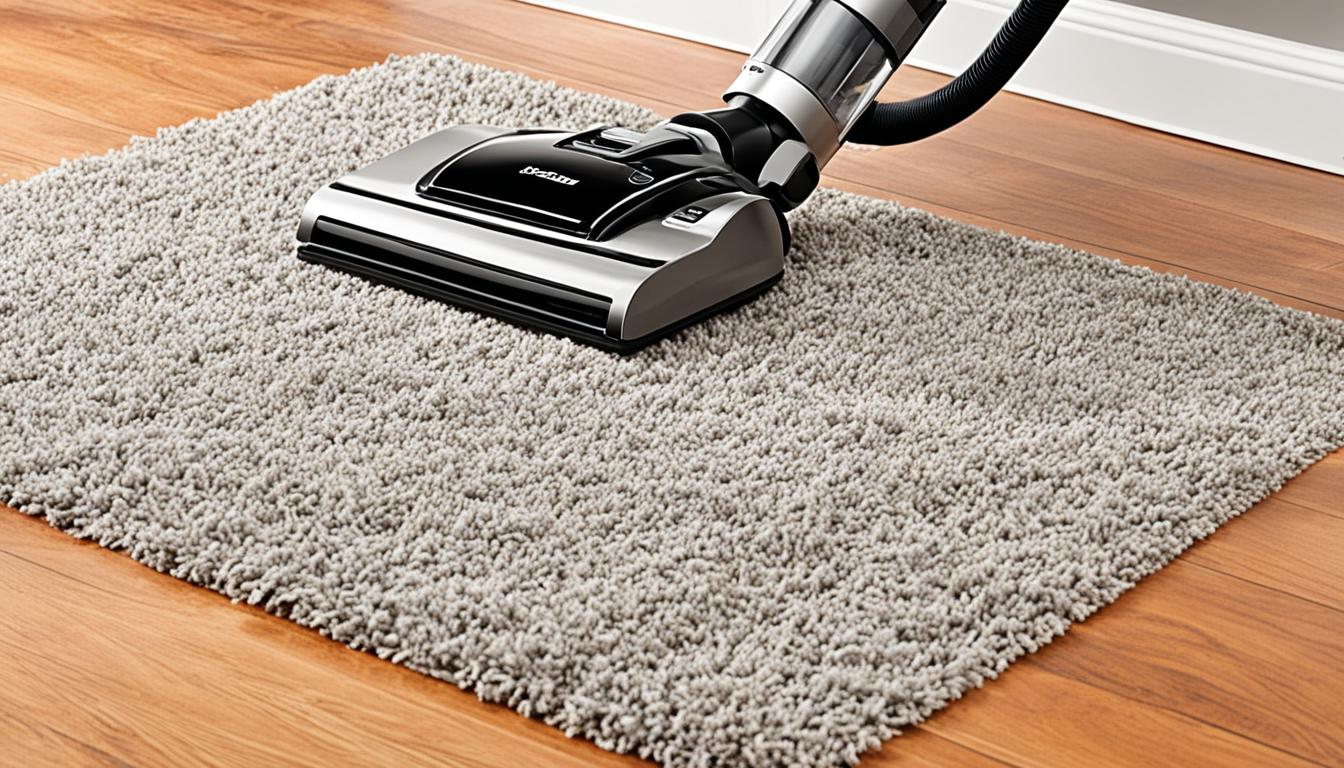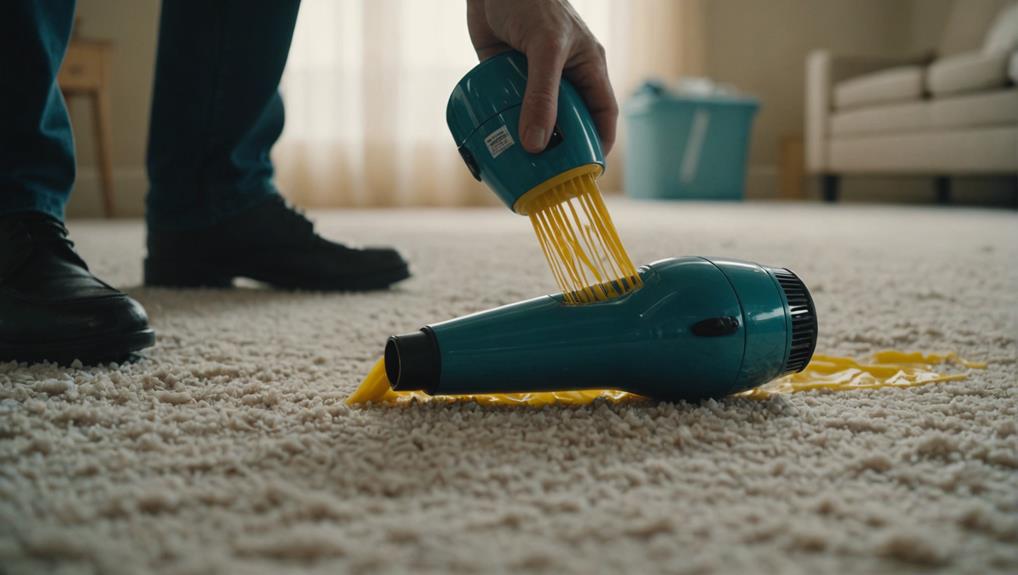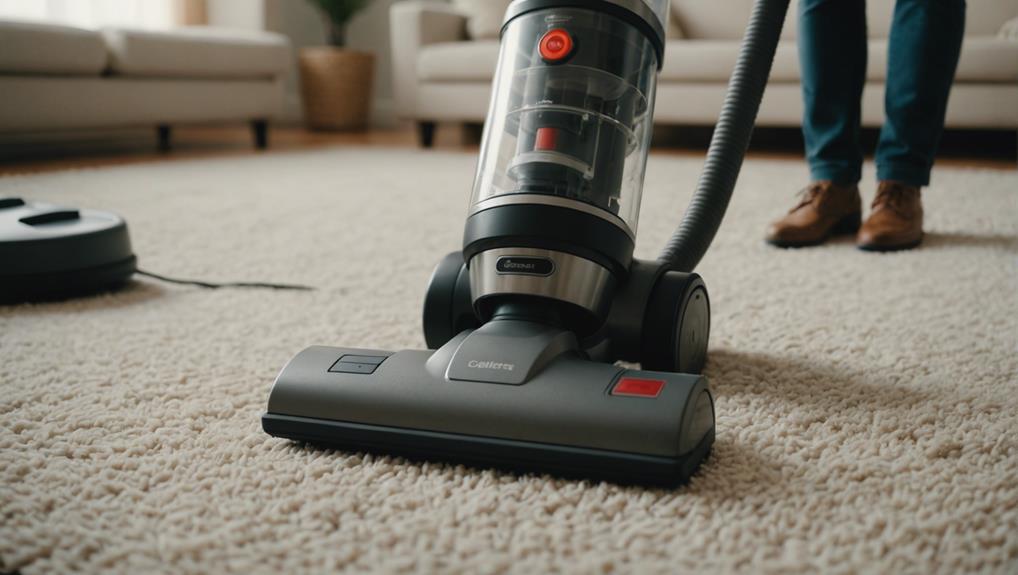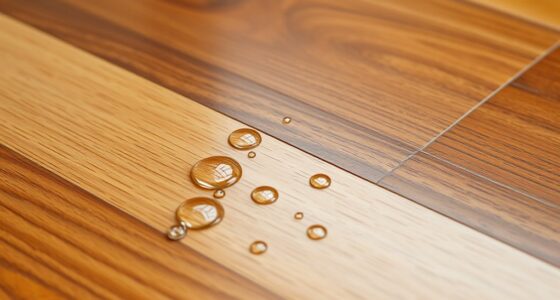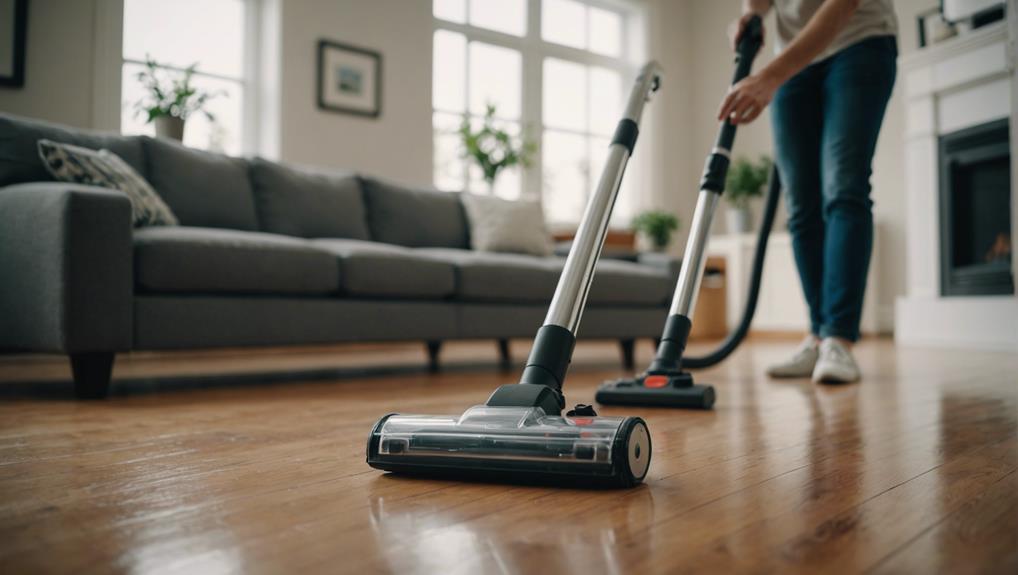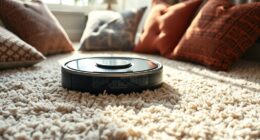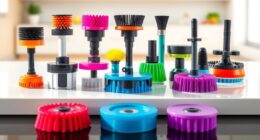Picture yourself strolling barefoot on sleek, polished hardwood floors. The room is bathed in warm sunlight, creating a sense of peace and comfort. However, maintaining the cleanliness and shine of your floors can be a challenging task. This is where the importance of having the right vacuum cleaner comes into play.
Buying a vacuum for hardwood means finding the perfect match. No more using methods that don’t work or might harm your floors. With the best vacuum, keeping your floors beautiful and clean is easy.
This guide will help you understand what to look for in a hardwood floor vacuum. We’ll discuss important features like powerful suction, long battery life, and smart technology. Get ready to ditch the dust and pet hair and welcome gleaming floors.
Key Takeaways:
- Choosing the right vacuum is crucial for your hardwood floors’ beauty and cleanliness.
- Look for features such as suction strength, long battery, anti-bacterial technology, and smart navigation in your vacuum.
- Robot vacuums like the Dreame F9 are smart and great at picking up pet hair. But hybrid vacuums may not work well on hardwood.
- The Miele Classic C1 Pure Suction and Miele Complete C3 Calima PowerLine are great options with strong cleaning power and good warranty.
- The Dyson V12 Detect Slim has cool features like a laser light for spotting dust. Yet, it has a smaller bin for dirt.
The Best Vacuum Options for Hardwood Floors
Having the right vacuum is key to cleaning hardwood floors well. With so many choices, picking the best one can seem hard. We’ve researched for you and found the top vacuums made for hardwood floors.
The Miele Classic C1 Pure Suction model tops our list. It has a strong 1,200-watt motor for good suction. This means it can pick up dirt and debris well. Plus, it’s quiet, operating between 57 and 69 decibels1.
Another top pick is the Miele Complete C3 Calima PowerLine. It’s great for hardwood floors and comes with a three-year warranty1. Its self-sealing bag feature stops dust and allergens from getting out. This makes your home’s air cleaner1.
If you like cordless vacuums, consider the Dyson V12 Detect Slim. Its 12-ounce dustbin means less emptying for you1. It’s light and has many attachments. This makes it useful for more than just floors2.
Choosing the right vacuum for hardwood floors means looking at suction, durability, and if it cleans gently but well. The vacuums we mentioned are great for these reasons. They leave hardwood floors clean and looking good, no matter which one you pick.
Top Vacuum Options for Hardwood Floors
| Vacuum Model | Features | |
|---|---|---|
| Miele Classic C1 Pure Suction | – 1,200-watt motor | – Operates between 57 and 69 decibels1 |
| Miele Complete C3 Calima PowerLine | – Self-sealing bag | – Three-year warranty for its Complete series1 |
| Dyson V12 Detect Slim | – 12-ounce dustbin1 | – Various attachments for versatile cleaning2 |
Choosing the Right Type of Vacuum for Hardwood Floors
Cleaning hardwood floors requires the right vacuum. There are different types, each with its own pros and cons. This helps you find the best match for your needs.
Here are the three main types of vacuums to look into:
1. Upright Vacuums
Upright vacuums are a favorite among homeowners. Their upright design makes them easy to use and store. They have strong suction and brush rolls. This makes them great for picking up dirt from hardwood floors.
Studies show upright vacuums like the Miele Classic C1 Pure Suction have a powerful 1,200-watt motor. This means strong suction for clean floors. Plus, Miele vacuums are quieter than other brands. They range from 57 to 69 decibels, while brands like Shark and Hoover can be louder, hitting 76-79 decibels.1
2. Canister Vacuums
Canister vacuums have a separate cleaning head and body connected by a hose. This design lets you easily clean under furniture and in tight spots. They come with different attachments, so they’re great for hardwood and other surfaces.
Miele’s Classic C1 series vacuums have top-notch filters. Their AirClean exhaust filter catches nearly all tiny particles. And their HEPA filter grabs even the smallest ones, ensuring the air stays clean while you vacuum1.
3. Stick Vacuums
Stick vacuums are light and easy to handle. They’re perfect for quick clean-ups. Their design lets you move easily around furniture and corners. Many are cordless, so you don’t have to worry about plugs when cleaning your floors.
Each vacuum type has its own advantages. The best choice depends on your home’s size, your floors’ layout, and how much they’re used.
With this info, you’re ready to pick the best vacuum for your hardwood cleaning needs.

Important Features to Consider for Hardwood Floor Vacuums
When picking a vacuum for your hardwood floors, it’s important to look at some key features. These include how strong it sucks, the type of brush roll, the filter system, how long the cord is, and the extra tools it comes with. Let’s dive into why these features matter for keeping your floors clean and in good shape.
Suction Power
Suction power matters a lot when choosing a vacuum for hardwood floors. If the vacuum is strong, it can pick up all kinds of dirt and dust well. This makes your floors really clean and stops dirt from scratching or harming the wood. The Dyson V12 Detect Slim is a good example because it’s strong on both floors and rugs1.
Brush Roll Type
The kind of brush roll a vacuum has is also key for hardwood floors. You should look for vacuums with brushes made specially for delicate floors. The Dyson V12 Detect Slim, for instance, has a Laser Slim Fluffy head that’s great for bare floors and doesn’t damage them1.
Filtration System
A good filter system is key for clean air when you vacuum hardwood floors. Vacuums with HEPA filters are great because they catch tiny bad stuff like allergens and dust. This keeps the air clean. HEPA filters help make sure tiny particles don’t get back into the room3.
Cord Length
The length of your vacuum’s cord can change how easy it is to use, especially in big spaces. A longer cord means you don’t have to change plugs often. But, a cordless vacuum, like the Dyson V12 Detect Slim, lets you move freely without any cord troubles1.
Attachments
Attachments add more ways to use your vacuum, especially for cleaning hardwood floors. Look for tools like soft brushes made for wood floors. These tools help you clean without scratching or harming the floor. They make it easy to reach spots and corners that are hard to get to1.
By looking at these important features when you choose a vacuum for your hardwood floors, you can clean well, keep your vacuum working great, and keep your floors looking beautiful for a long time.
Addressing Common Concerns: Scratching and Cleaning Efficiency
Vacuuming hardwood floors often raises two key worries: the chance of scratches and how well it cleans. It’s important to pick a vacuum that’s kind to hardwood floors. This way, you can clean your floors well without leaving any marks.
Cleaning your floors correctly prevents scratching. Plus, it ensures your vacuum works as efficiently as possible.
Gentle Cleaning for Scratch-Free Floors
Hardwood floors look great but are easy to scratch. To protect them, choose a vacuum with soft bristles or microfiber pads. This type of cleaning tool4 gently gets rid of dirt without harming your floors.
To keep your hardwood floors in top shape, take extra steps besides picking a soft vacuum. Use furniture pads, avoid high heels or long pet nails on the floor, and put down rugs in busy areas. These actions shield your floors from scratches4.
Cleaning Efficiency for Optimal Results
Cleaning your floors well is just as important as avoiding scratches. You want a vacuum that gets rid of all the mess, including pet hair. This leaves your hardwood looking perfect. Achieving great cleaning results involves several factors:
- Strong Suction Power: Choose a vacuum that can pull up dirt well. Good suction gets all the grime out of your floors.
- Appropriate Attachments: Use a vacuum with tools made for hardwood. A soft brush attachment or a floor brush works best.
- Effective Filtration System: The right vacuum captures even the tiniest particles5. Look for one that keeps dust and allergens inside. This helps keep the air and your floors clean5.
When you pick a vacuum that’s gentle and cleans well, your hardwood floors will stay beautiful. With the right care, they’ll look great and be free of scratches and dirt.

Factors to Consider for Pet Owners
If you have pets, choosing the right vacuum for your floors is key. As a pet owner, you have to think about extra things. This helps keep your place clean and deals with pet hair and allergens.
Pet hair removal from floors is a big deal for pet owners. The Dreame F9 robot vacuum, with strong suction of 2500 pa, is made for this job. It gets rid of pet hair well, helping lower allergens6.
Besides pet hair, messes from pets can be tough to clean up. Extras like pet brushes and crevice tools help a lot. They get into hard spots and clean up pet messes on hardwood floors. The Dreame F9 has these tools6.
Odors and allergens from pets worry many. The Dreame F9 robot vacuum is built to fight bacteria. It keeps your floors clean and reduces allergens. This makes your home healthier for you and your pets6.
Statistics at a Glance:
From data7, 40% of UK households have a pet, mostly dogs and cats. This is big to keep in mind when picking a vacuum for your floors.
If you own a pet, vacuuming your floors at least twice a week is suggested. Regular vacuuming cuts down on pet hair. This keeps your home tidy7.
The kind of wood flooring you have affects cleaning. Engineered wood, often in bathrooms, needs careful cleaning to avoid harm. You need the right tools7.
Choosing the right finish for your floors is also key. Unfinished flooring lets you pick a pet-friendly finish. This fights against scratches and dents. Light colored floors can hide pet damage well, keeping them looking good7.
“For pet owners, getting a vacuum that tackles pet hair on floors is vital. The Dreame F9 robot vacuum has mighty suction, special tools for messes, and fights bacteria. It keeps your place free from allergens.” – Reference6
Keeping these points in mind and using a pet-friendly vacuum like the Dreame F9, you can keep your floors clean. This makes a happier space for you and your pets.
| Statistical Data | Source |
|---|---|
| 40% of UK households own a pet | Link 3 |
| 24% of households own dogs | Link 3 |
| 17% of households own cats | Link 3 |
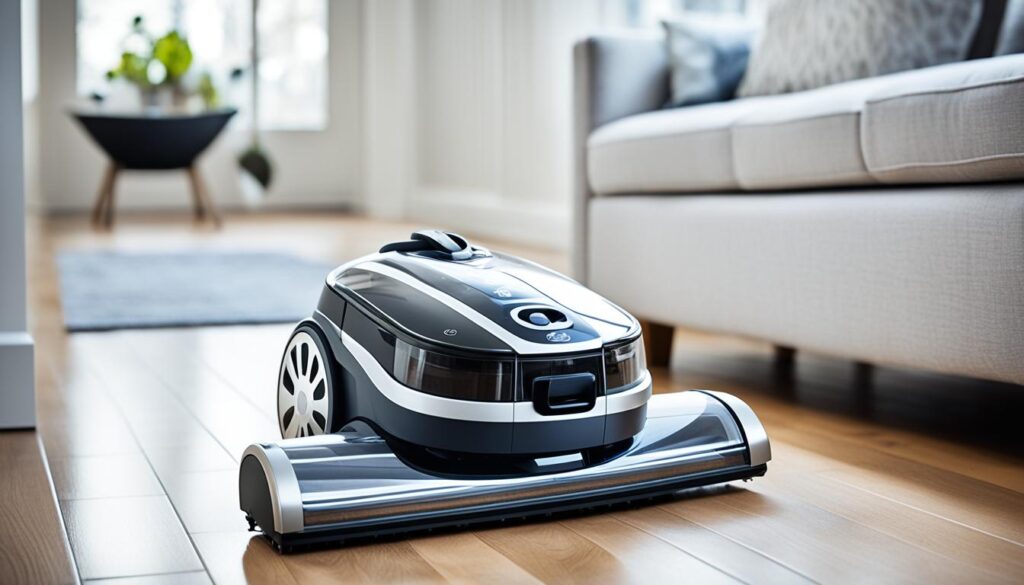
Budget-Friendly Options for Hardwood Floor Vacuums
Looking for a vacuum that’s easy on your wallet but great for hardwood floors? There are many good choices that won’t cost you a lot. Customers and experts both like these for being affordable and high-quality.
Miele Classic C1 Pure Suction
Think about the Miele Classic C1 Pure Suction. It’s not too pricey and works well on hardwood. It has a strong 1,200-watt motor to clean up dirt and dust. It’s also quieter than many, making less noise.
It uses an AirClean filter that traps almost all small particles. This means the air in your home stays clean1.
Miele Complete C3 Calima PowerLine
The Miele Complete C3 Calima is another wallet-friendly pick. It’s great for hardwood and has handy tools like a crevice tool and dust brush. All these tools are easy to find on the canister1.
It also has self-sealing bags. This keeps dust and allergies from getting back into the air1.
Dyson V12 Detect Slim
Prefer no cords? The Dyson V12 Detect Slim might be for you. It cleans hardwood floors well and lasts up to 45 minutes per charge. But, its dustbin is small. You might need to empty it a few times if cleaning a whole house or if you have pets.
Choosing the right vacuum means thinking about what you need. Consider things like how it cleans on hardwood, ease of use, and warranty. Finding the right one within your budget means clean floors without spending too much.
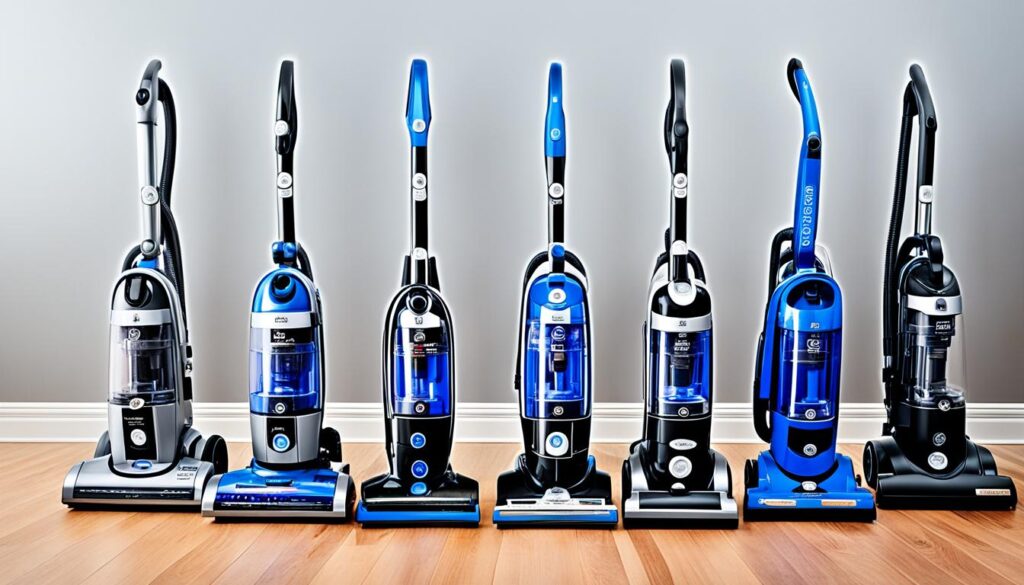
| Vacuum Model | Suction Power | Noise Level (Decibels) | Filtration System |
|---|---|---|---|
| Miele Classic C1 Pure Suction | 1,200 watts | 57-69 decibels1 | AirClean exhaust filter1 |
| Miele Complete C3 Calima PowerLine | N/A | N/A | N/A |
| Dyson V12 Detect Slim | N/A | N/A | N/A |
Maintenance and Care Tips for Hardwood Floor Vacuums
To keep your hardwood floor vacuum working its best, good care is vital. Following some simple tips will ensure your vacuum lasts longer.
Cleaning the Dust Container and Filters
Regular cleaning of the vacuum’s dust container is key for its power and to avoid clogs. Check the manual on how to do this right. Also, clean or change the filters as the manual suggests. This helps stop dust and allergies from building up inside your vacuum6.
Checking and Cleaning the Brush Roll
The brush roll might get clogged with hair and debris. It’s important to check and clean it regularly. You may need to take the brush roll out to clean it properly, based on your vacuum’s model. Look at the manual for how to keep the brush roll in good shape6.
Inspecting and Cleaning the Nozzles and Attachments
Make sure the nozzles and attachments are free from blockages. A soft cloth or a brush can be used to clean them. This step ensures they work well and the vacuum has proper airflow6.
Checking and Replacing Belts and Brushes
Belts and brushes can wear out or get damaged. Check them often for any signs of problems. Changing worn-out belts and brushes helps your vacuum work better. Read the manual to learn about checking and replacing them6.
Storing Your Hardwood Floor Vacuum
Storing your vacuum correctly is essential to prevent dust and damage. Make sure it’s off and unplugged before storing. Keep it in a clean, dry place away from direct sun and extreme temperatures. A vacuum bag or cover can add extra protection6.
Regular Maintenance Schedule
A regular maintenance schedule is important for your vacuum’s performance. This means cleaning the dust container, filters, checking the brush roll, attachments, and storing it right. By keeping a maintenance routine, your vacuum will clean efficiently and last longer6.
Recommended Maintenance Schedule for Hardwood Floor Vacuums
| Maintenance Task | Frequency |
|---|---|
| Empty and clean the dust container | After each use |
| Clean or replace filters | Every 1-3 months |
| Clean brush roll | Monthly |
| Inspect and clean nozzles and attachments | Monthly |
| Check and replace belts and brushes | As needed |
| Store vacuum properly | After each use |
Always check the user manual for your specific vacuum’s maintenance needs. Following a regular care routine will help extend its life and keep it cleaning well.
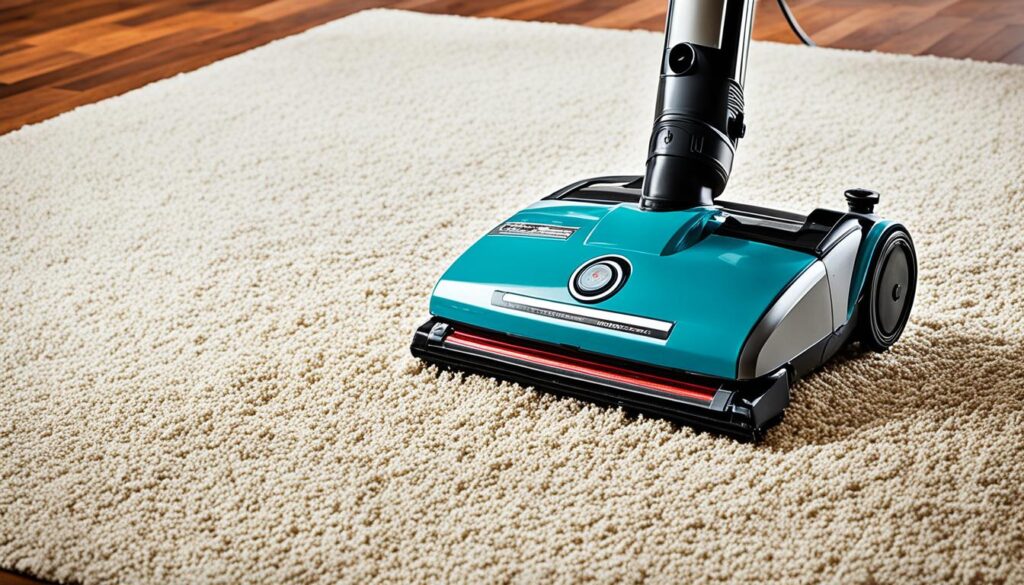
Image: Hardwood Floor Vacuum Maintenance
Customer Reviews and Recommendations
Looking for the right vacuum for hardwood floors can be made easier by listening to others. Here are some positive things people have said about their vacuums:
“I bought the Miele Classic C1 Pure Suction and it’s been great for my hardwood floors. It doesn’t cost too much, it’s light, and sucks up dirt really well. Plus, its filter catches almost all tiny particles, making my home’s air cleaner. I really suggest getting one!”1
Someone else was happy with the Tineco FLOOR ONE S5:
“After using a German vacuum for years, I tried the Tineco FLOOR ONE S5. I’m so glad I did. It’s perfect for both dry and wet messes, and it knows when to work harder in dirtier spots. It gets everything, from cat litter to pine needles. Just clean it well after using it to stop smells!”8
Another person loved the Shark – Navigator Lift-Away Upright Vacuum:
“The Shark – Navigator Lift-Away Upright Vacuum has been amazing for my hardwood floors. It keeps allergens from spreading in my house. Plus, it’s super powerful and does a great job, just as the reviews said!”9
Last, someone else talked about how good the Dyson – Ball Animal 3 Extra Upright Vacuum is:
“With pets at home, I needed a strong vacuum. The Dyson – Ball Animal 3 Extra Upright Vacuum has been perfect. Its strong suction and many tools make cleaning pet hair easy. My floors look great. It even has extra tools for tight spots. I highly recommend it to pet owners!”9
These reviews give us a good idea about how these vacuums work on hardwood floors. Think about these opinions as you choose the best vacuum for your home.
Conclusion
When you’re buying a vacuum for your hardwood floors, it’s key to look at the features and cleaning power. Think about what fits your home best. With the advice in this guide, you’ll know how to pick the perfect vacuum for your floors.
Hardwood floors are more and more popular, with the industry earning $3 billion in 201710. Their long-lasting beauty makes them a favorite for many homeowners.
Choosing the right wood and finish, like solid wood for rooms not on the ground and engineered wood for damp areas10, helps your floors last longer. Keeping them clean by sweeping, vacuuming, and using the right products is essential10.
There are many good vacuums out there for hardwood floors. The BONA Hardwood Floor Cleaner, trusted for a decade, is a great pick11. The Dyson V6 Absolute stands out for being affordable and easy to carry11. Then, there’s the Swiffer Sweep + Vac, a cordless option that makes cleaning simple11.
FAQ
What factors should I consider when purchasing a vacuum for hardwood floors?
Are there different types of vacuums available for cleaning hardwood floors?
How can I ensure that the vacuum I choose is gentle on hardwood surfaces?
How do I find a vacuum that effectively removes pet hair?
Are there budget-friendly options available for vacuuming hardwood floors?
How do I properly maintain and care for my hardwood floor vacuum?
Can customer reviews and recommendations help me choose a vacuum for hardwood floors?
Which Type of Vacuum is Best for Hardwood Floors?
When it comes to the canister vs upright vacuum choice for hardwood floors, it ultimately depends on personal preference. Canister vacuums are typically more maneuverable and have a variety of attachments for different surfaces, while upright vacuums can be more convenient for quick clean-ups. Both can be effective on hardwood floors.
Source Links
- https://www.nytimes.com/wirecutter/reviews/best-vacuum-for-hardwood-floors/
- https://nymag.com/strategist/article/best-vacuums.html
- https://www.theclintoncourier.net/2023/07/25/what-to-look-for-when-buying-a-vacuum-cleaner-key-considerations/
- https://mrsander.co.uk/blog/whats-the-best-way-to-keep-your-wooden-floors-clean/
- https://cleanmyspace.com/the-complete-guide-to-using-a-dyson-v11/
- https://global.dreametech.com/blogs/blog/how-to-choose-a-robot-vacuum-for-hardwood-floor
- https://www.sanding.co.uk/news/blog-floor-maintenance/hardwood-flooring-and-dogs.html
- https://www.apartmenttherapy.com/tineco-wet-dry-vacuum-review-37041500
- https://www.bestbuy.com/site/shop/best-vacuum-for-hardwood-floors-and-carpet
- https://www.firstclasswoodfloors.com/blog-1/the-ultimate-guide-before-buying-hardwood-floors-questions-to-ask
- https://carolineondesign.com/how-to-clean-engineered-wood-floors/
